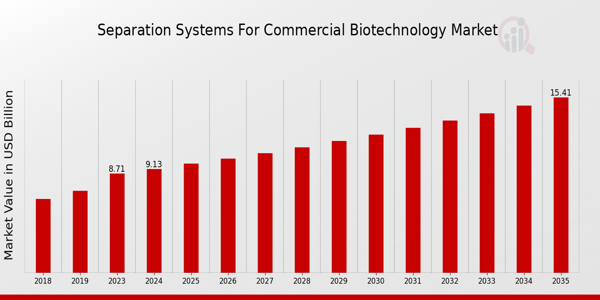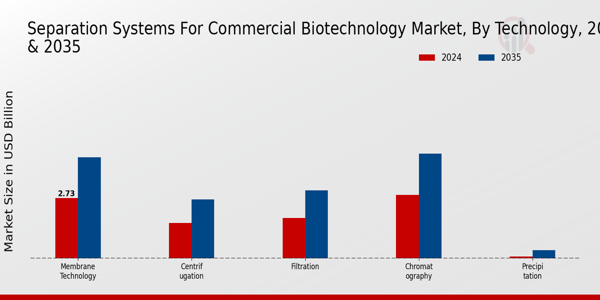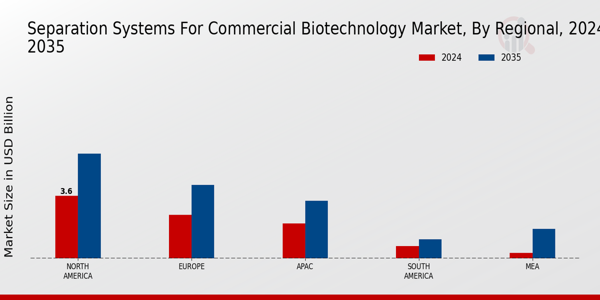Separation Systems for Commercial Biotechnology Market Overview:
As per MRFR analysis, the Separation Systems for Commercial Biotechnology Market Size was estimated at 8.71 (USD Billion) in 2023.The Separation Systems for Commercial Biotechnology Market is expected to grow from 9.13(USD Billion) in 2024 to 15.4 (USD Billion) by 2035. The Separation Systems for Commercial Biotechnology Market CAGR (growth rate) is expected to be around 4.87% during the forecast period (2025 - 2035).
Key Separation Systems for Commercial Biotechnology Market Trends Highlighted
The growing need for tailored therapeutics and biopharmaceuticals is propelling the global separation systems market for commercial biotechnology. Businesses are compelled by this demand to implement effective separation technologies in order to improve the yield and purity of their products.
The demand for cutting-edge treatments and the increase of chronic illnesses are driving the use of novel separation techniques. Separation systems are a crucial part of bioprocessing since regulatory demands are also forcing businesses to improve quality control in order to assure compliance. As separation technologies continue to progress, there are several opportunities.
The integration of automation and AI into separation processes presents a chance for companies to improve efficiency and reduce operational costs. Moreover, the increasing focus on sustainable practices in biotechnology opens avenues for green separation technologies, catering to a growing environmentally conscious market.
Companies can explore collaborations with research institutions to innovate and develop next-generation separation systems. Recent trends indicate a shift towards bioprocessing advancements that embrace both efficiency and cost-effectiveness.
The emphasis on continuous processing over traditional batch processing is gaining traction, as it allows for real-time monitoring and can significantly improve production timelines. Furthermore, the rapid development of single-use technologies is reshaping manufacturing landscapes, offering flexibility and reducing cross-contamination risks.
With these shifts, organizations are actively investing in research and development to stay competitive in a dynamic market landscape. The continuous evolution of separation systems is set to play a crucial role in enhancing biotechnological processes, driving innovation, and meeting the growing demands of the global market.

Source: Primary Research, Secondary Research, MRFR Database and Analyst Review
Separation Systems for Commercial Biotechnology Market Drivers
Rising Demand for Biopharmaceuticals
The is experiencing significant growth due to the rising demand for biopharmaceuticals. As healthcare systems increasingly focus on precision medicine and targeted therapies, the need for efficient separation processes becomes paramount.
This is driven by the growing prevalence of chronic diseases, which require advanced therapeutic solutions. The biopharmaceutical sector relies heavily on sophisticated separation techniques to ensure the purity, stability, and efficacy of therapeutic products.
With the global biopharmaceutical market poised for growth, the demand for state-of-the-art separation systems tailored for commercial biotechnology applications is expected to rise accordingly. Additionally, technological advancements in separation methodologies, such as affinity chromatography and membrane filtration, enhance product yield and reduce operational costs.
This further propels the adoption of these systems in biopharmaceutical manufacturing processes, establishing a robust driver for the .
Furthermore, as biopharmaceutical companies seek to innovate and shorten production times, investments in cutting-edge separation technologies will likely increase, influencing market dynamics positively. The confluence of these factors signals a thriving market environment for separation systems tailored specifically for the biotechnology sector.
Technological Advancements in Separation Technologies
Technological advancements in separation technologies are a key driver propelling the forward. With the emergence of novel techniques and improvements in existing methods, industries are able to enhance efficiency, scalability, and integration into bioprocessing workflows.
Innovations such as high-throughput screening, automated systems, and real-time monitoring of separation processes allow for optimized operations and reduced costs. These advancements cater to the increasing demand for higher purity levels in the final products, which is crucial for compliance with regulatory standards.
As separation technologies continue to evolve, they will play a pivotal role in shaping the future landscape of the biotechnology sector, driving the need for more sophisticated separation systems that meet commercial requirements.
Increasing Investments in Biotechnology Research
The increasing investments in biotechnology research are a significant driver for the . Governments, private investors, and organizations are collectively ramping up funding aimed at advancing biotechnology research and development.
This influx of capital enables the exploration of new therapies, diagnostics, and agricultural products, thereby augmenting the demand for efficient separation systems. As researchers strive for innovative solutions in fields such as genomics, proteomics, and synthetic biology, there is an escalating requirement for advanced separation technologies to isolate biomolecules effectively.
Consequently, this trend positively impacts the market as it fosters an ecosystem ripe for the deployment of enhanced separation systems tailored for various commercial applications.
Separation Systems for Commercial Biotechnology Market Segment Insights:
Separation Systems for Commercial Biotechnology Market Technology Insights
The demonstrated a robust landscape characterized by diverse technological methodologies aimed at enhancing efficiency and efficacy in bioprocesses. Within this market, several technologies played vital roles, providing unique mechanisms to separate and purify biological materials essential for research and commercial applications.
Membrane Technology stood as a prominent segment, valued at 2.73 USD Billion in 2024 and growing to 4.56 USD Billion by 2035, suggesting its crucial role in applications requiring selective separation processes, such as dialysis and ultrafiltration, which were pivotal in various industries including pharmaceuticals and food processing.
Meanwhile, Centrifugation, with a market value of 1.6 USD Billion in 2024, also showed growth prospects, reaching 2.67 USD Billion by 2035. This technology was significant for its efficiency in separating cellular components and proteins based on density differences, making it invaluable in laboratories and production settings.
Filtration, valued at 1.83 USD Billion in 2024 and expected to rise to 3.07 USD Billion thereafter, was essential for its ability to remove particulates and other contaminants from liquids, thereby enhancing the purity of final products.
Chromatography, another major player in this sector, demonstrated a market value of 2.87 USD Billion in 2024, projected to reach 4.73 USD Billion by 2035. This technique is prominently employed for purification and separation of complex mixtures, essential in drug development and research.
Though the Precipitation technology accounted for the smallest share, with a valuation of 0.1 USD Billion in 2024 and expected to ascend to 0.37 USD Billion by 2035, it still held importance mainly for its cost-effectiveness and simplicity in obtaining solid products from solutions.
Collectively, these technologies reflected a significant market growth potential and illustrate the divisions within the , each contributing uniquely to the advancements in biotechnology.
With market trends leaning towards automation and efficiency, challenges such as operational costs and technological complexity also emerge, offering opportunities for continued innovation within this sector.

Source: Primary Research, Secondary Research, MRFR Database and Analyst Review
Separation Systems for Commercial Biotechnology Market Application Insights
The is reflecting its growing importance in various applications, including Drug Discovery, Vaccine Production, Protein Purification, Cell Harvesting, and Gene Therapy.
Each application plays a crucial role; for instance, Drug Discovery has seen significant advancements driven by the necessity for effective therapeutic solutions. Vaccine Production remains vital, especially in light of recent global health challenges, maintaining a robust demand for efficient separation systems.
Protein Purification is fundamental for producing high-quality proteins used in therapeutics, indicating a significant market growth in this area. Cell Harvesting is increasingly pivotal due to its applications in regenerative medicine and cell therapy, which are rapidly evolving fields in biotechnology.
Gene Therapy, as a transformative approach to treating genetic disorders, relies heavily on efficient separation methods, securing its significance within the market.
The diversity of applications underscores the 's extensive segmentation, which caters to various industry needs while influencing revenue and overall market growth.
Separation Systems for Commercial Biotechnology Market End Use Insights
The market encompasses critical areas such as Pharmaceuticals, Research Laboratories, Biotechnology Companies, Diagnostics, and Biomanufacturing. The Pharmaceuticals sector significantly influences market dynamics due to the increasing demand for innovative drug development and production processes, which require efficient separation technologies.
Research Laboratories also play a vital role, as they utilize these systems for various analytical applications and experimental setups, ensuring precision in results. Meanwhile, Biotechnology Companies leverage advanced separation systems to optimize bioprocessing, enhancing overall productivity and product quality.
Diagnostics is another key area, driven by the necessity for accurate separation methods in disease detection and monitoring. Lastly, Biomanufacturing stands out as a rapidly growing segment, focusing on the production of biological products, where separation systems are essential for streamlining processes and improving yield.
Our understanding of the data reveals that these sectors are integral to the overall market's success, showcasing significant opportunities for future growth.
Separation Systems for Commercial Biotechnology Market Product Type Insights
The market is segmented into several key categories, including Separation Modules, Complete Separation Systems, Consumables, Accessories, and Software Solutions. Among these, Separation Modules are crucial for their versatility in applications, as they offer various forms of separation methods integral to biotechnology processes.
Complete Separation Systems also play a significant role by providing comprehensive solutions that combine various separation techniques, streamlining operations for companies. Consumables are expected to dominate due to their consistent need in ongoing experiments and industrial processes, serving as essential components for maintaining efficient workflows.
Accessories enhance the performance and adaptability of separation systems by providing necessary tools for optimized operations. Lastly, Software Solutions are gaining traction as they facilitate data management and process control, which is essential in today's data-driven landscape.
Overall, the market dynamics are influenced by technological advancements, increasing demand for biopharmaceuticals, and the need for efficient separation techniques across various applications within the biotechnology industry.
Separation Systems for Commercial Biotechnology Market Regional Insights
The Regional segmentation of the Global Separation Systems for the Commercial Biotechnology Market revealed significant insights into its structure and growth across various territories.
With the market valued at 3.6 USD Billion in North America for 2024 and expected to grow to 6.0 USD Billion by 2035, it held the majority share, showcasing its dominance due to advanced infrastructure and high levels of investment in biotechnology. Europe followed, with a valuation of 2.5 USD Billion in 2024, rising to 4.2 USD Billion by 2035, driven by innovation and regulatory support in biotechnological research.
The APAC region, valued at 2.0 USD Billion in 2024, reflected a significant growth trajectory, anticipated to reach 3.3 USD Billion by 2035, fueled by increasing demand for biotechnology solutions and funding for research initiatives.
Meanwhile, South America and MEA markets showed smaller valuations of 0.7 USD Billion and 0.33 USD Billion in 2024, respectively, with potential for growth, particularly in MEA, which is projected to reach 1.7 USD Billion by 2035.
These figures underscored the varying dynamics and growth drivers, highlighting both opportunities and challenges within the landscape.

Source: Primary Research, Secondary Research, MRFR Database and Analyst Review
Separation Systems for Commercial Biotechnology Market Key Players and Competitive Insights:
The is characterized by a rapidly evolving landscape driven by advancements in technology and increasing demand for biopharmaceuticals and biotechnological applications.
As various stakeholders vie for market share, competition centers around innovation, product performance, and the ability to cater to diverse applications within the biotechnology sector. Key players are focusing on enhancing their separation technologies to improve efficiency, reliability, and scalability.
Market participants are also engaging in strategic collaborations, mergers, and acquisitions to strengthen their foothold and expand their product offerings. Overall, the competitive environment is marked by a blend of established companies with extensive experience and emerging players carving niches through novel approaches.
Waters Corporation stands out in the due to its commitment to innovation and superior product offerings. The company has positioned itself as a leader with a robust portfolio of analytical instruments and systems that cater specifically to the needs of the biotechnology sector.
Waters Corporation focuses on providing highly efficient separation solutions that enhance the productivity and accuracy of biochemical analyses. With a strong emphasis on R&D, the company invests significantly in developing cutting-edge technologies that fulfill evolving regulatory and market demands.
Additionally, Waters Corporation's solid customer relationships and extensive global distribution network bolster its market presence and support its efforts in delivering top-tier separation systems tailored for biotechnological applications.
Eppendorf, a notable player in the , has gained recognition for its specialized products designed to meet the unique needs of life sciences and biotechnology.
The company emphasizes creating innovative separation solutions that are not only effective but also user-friendly, thereby simplifying complex biotechnological workflows. Eppendorf’s strength lies in its precise engineering and commitment to quality, which enhances the reliability of its separation systems.
The company actively engages with research institutions and biotech firms, ensuring that its solutions integrate seamlessly into existing processes. Eppendorf’s well-established presence in the market is further supported by its robust customer service, which reinforces client loyalty and provides ongoing support for the various applications of its separation technologies.
Key Companies in the Separation Systems for Commercial Biotechnology Market Include:
Waters Corporation
Eppendorf
Danaher Corporation
Ksep Technology
Sartorius AG
Pall Corporation
Molecular Devices
Repligen Corporation
MilliporeSigma
PerkinElmer
Agilent Technologies
Thermo Fisher Scientific
BioRad Laboratories
GE Healthcare
Tosoh Bioscience
Separation Systems for Commercial Biotechnology Market Developments
Recent developments in the indicate a strong focus on innovation and collaboration among major players. Companies like Waters Corporation and Thermo Fisher Scientific have been enhancing their product lines to integrate advanced technologies that optimize separation processes.
Eppendorf and Sartorius AG have reported increased investments in research and development, emphasizing their commitment to developing next-generation biotechnology solutions.
The market is witnessing a growth pattern, significantly impacted by the demand for high-purity bioseparation techniques, especially from entities such as Pall Corporation and MilliporeSigma, which are expanding their production capabilities to meet rising global demand.
Additionally, recent mergers and acquisitions, particularly Danaher Corporation's acquisition of a prominent biotech firm, suggest a trend towards consolidation aimed at broadening market reach and enhancing technological capabilities. Agilent Technologies and Repligen Corporation are also exploring strategic partnerships to enhance their competitive position.
Market growth remains robust, driven by the relentless pursuit of efficiency and cost-effectiveness influenced by ongoing advancements in automation and process analytics. Global healthcare trends further fuel investment interests as biotechnology firms increasingly seek to leverage sophisticated separation technologies for innovative therapeutics.
Separation Systems for Commercial Biotechnology Market Report Scope
| Attribute/Metric Source: |
Details |
| MARKET SIZE 2023 |
8.71(USD Billion) |
| MARKET SIZE 2024 |
9.13(USD Billion) |
| MARKET SIZE 2035 |
15.4(USD Billion) |
| COMPOUND ANNUAL GROWTH RATE (CAGR) |
4.87% (2025 - 2035) |
| REPORT COVERAGE |
Revenue Forecast, Competitive Landscape, Growth Factors, and Trends |
| BASE YEAR |
2024 |
| MARKET FORECAST PERIOD |
2025 - 2035 |
| HISTORICAL DATA |
2019 - 2024 |
| MARKET FORECAST UNITS |
USD Billion |
| KEY COMPANIES PROFILED |
Waters Corporation, Eppendorf, Danaher Corporation, Ksep Technology, Sartorius AG, Pall Corporation, Molecular Devices, Repligen Corporation, MilliporeSigma, PerkinElmer, Agilent Technologies, Thermo Fisher Scientific, BioRad Laboratories, GE Healthcare, Tosoh Bioscience |
| SEGMENTS COVERED |
Technology, Application, End Use, Product Type, Regional |
| KEY MARKET OPPORTUNITIES |
Increased demand for biopharmaceuticals, Expansion in emerging markets, Advances in separation technologies, Growing need for sustainable solutions, Rising investments in R&D initiatives |
| KEY MARKET DYNAMICS |
Technological advancements in separation techniques, Increasing demand for biopharmaceutical products, Rise in R&D investments, Stringent regulatory standards, Growing focus on sustainability |
| COUNTRIES COVERED |
North America, Europe, APAC, South America, MEA |
Frequently Asked Questions (FAQ) :
The overall market is expected to be valued at 9.13 USD Billion in 2024.
By 2035, the market is expected to reach a value of 15.4 USD Billion.
The market is expected to grow at a CAGR of 4.87% from 2025 to 2035.
Key technologies include Membrane Technology, Centrifugation, Filtration, Chromatography, and Precipitation.
North America is expected to dominate the market, valued at 3.6 USD Billion in 2024.
The Membrane Technology segment is projected to be valued at 4.56 USD Billion in 2035.
Major players include Waters Corporation, Eppendorf, and Danaher Corporation among others.
The Filtration segment is anticipated to reach 3.07 USD Billion by 2035.
The APAC region is projected to grow from 2.0 USD Billion in 2024 to 3.3 USD Billion in 2035.
Challenges may include regulatory hurdles and the high cost of technology adoption in biotechnology applications.

















